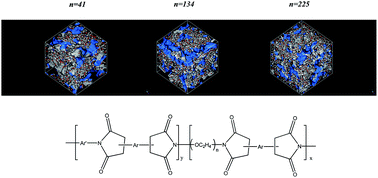Poly(ether–amide) vs. poly(ether–imide) copolymers for post-combustion membrane separation processes
Abstract
This work is focused on the comparison between the commercial polyamide PEBAX® MH 1657 and a new set of synthetized polyimides with different polyethylene glycol lengths. The samples were synthesized with the same poly(ethylene oxide) (PEO) content (57 wt%) for comparison with the commercial polymer. All polymers have been characterized by several techniques revealing a direct relationship between crystallinity, PEO length and permeability properties. Results at temperatures lower than the Tm of the polyether blocks confirm that lower PEO crystallinity corresponds to higher permeability. At temperatures higher than the Tm of the PEO block, no significant differences were found between the commercial polyamides and the synthesized polyimides. This confirms that the aliphatic phase controls the separation while the hard block provides mechanical strength. Remarkable are the results for the CO2/N2 separation. These new copolyimides are promising materials for post-combustion processes.


 Please wait while we load your content...
Please wait while we load your content...